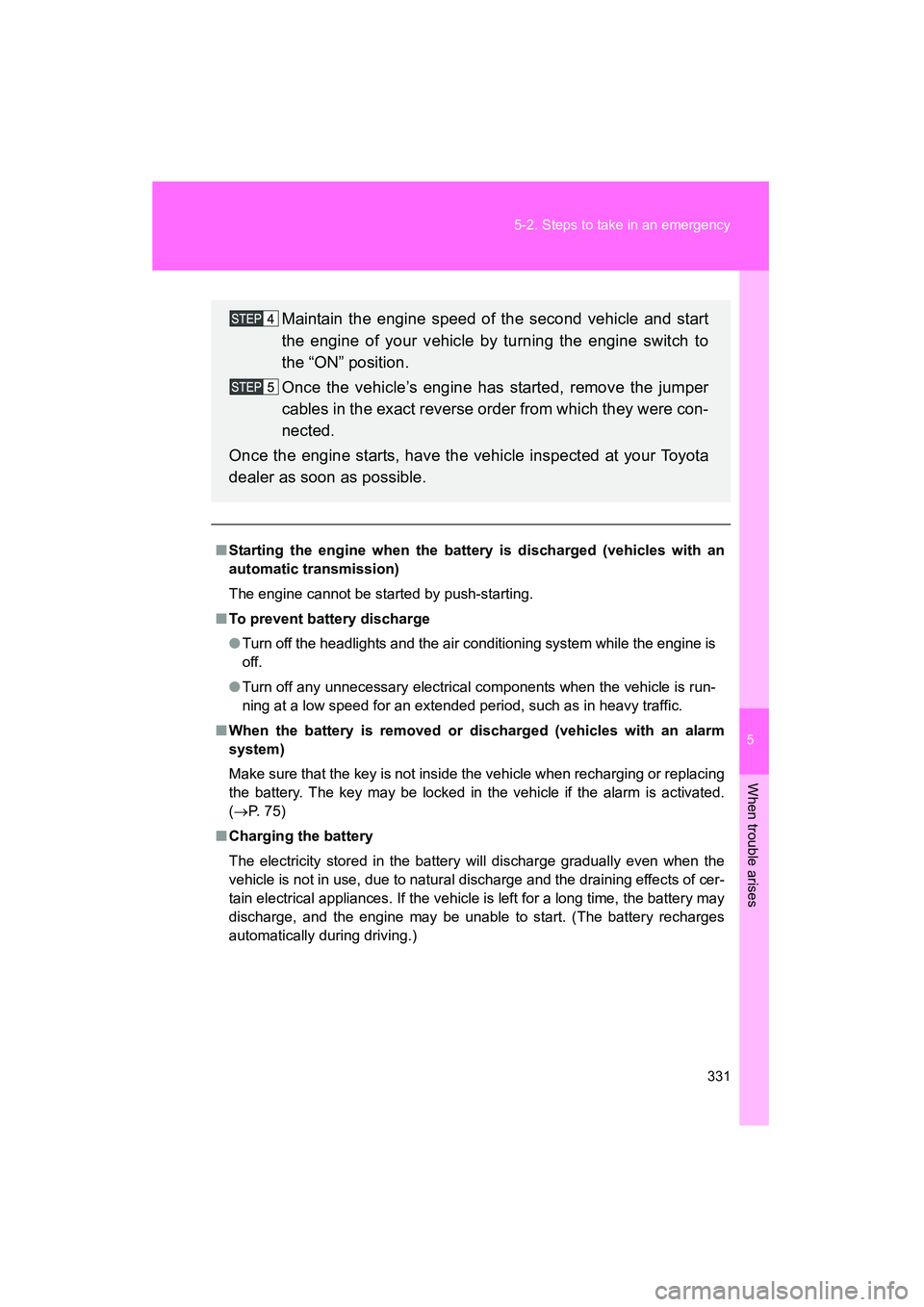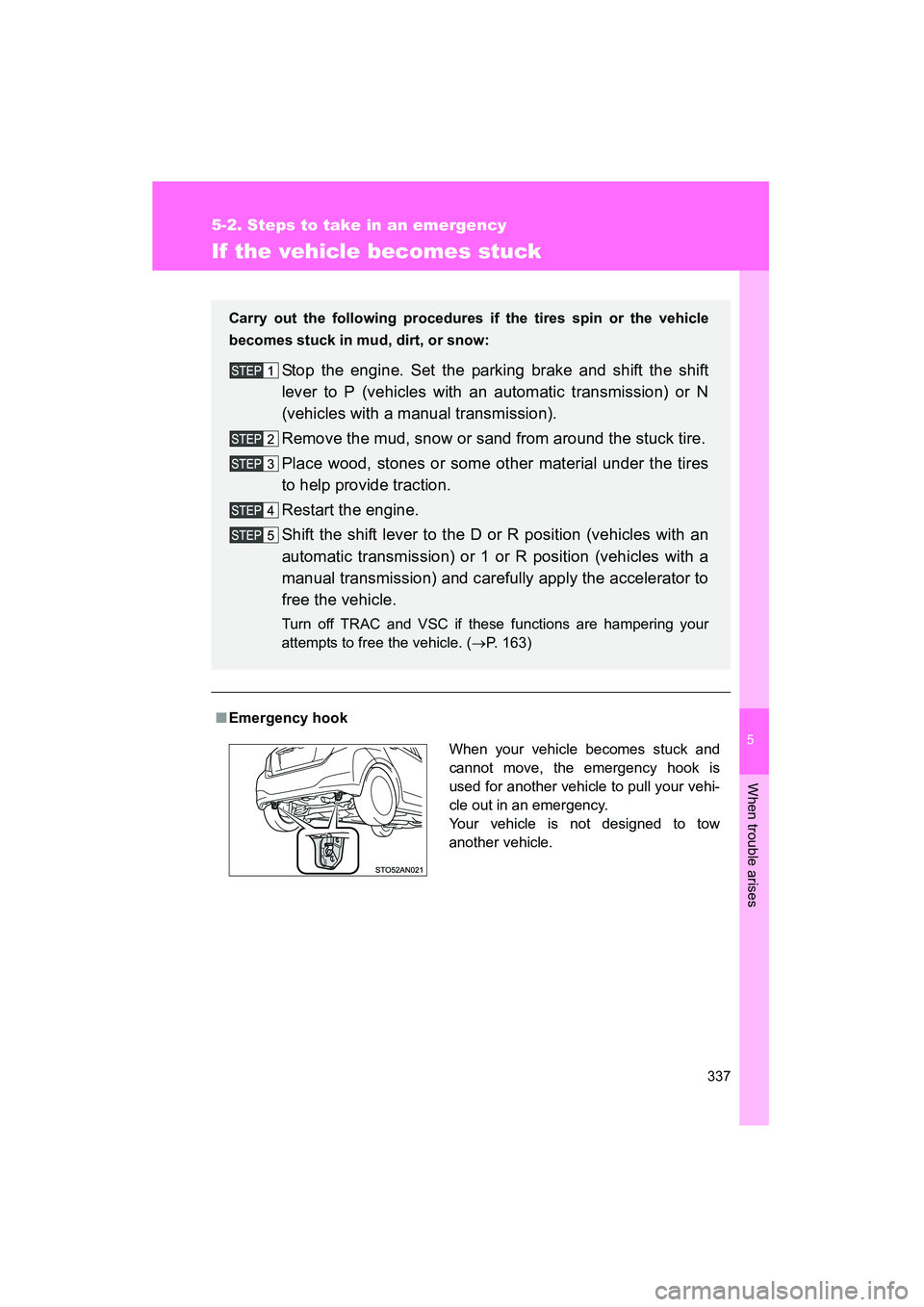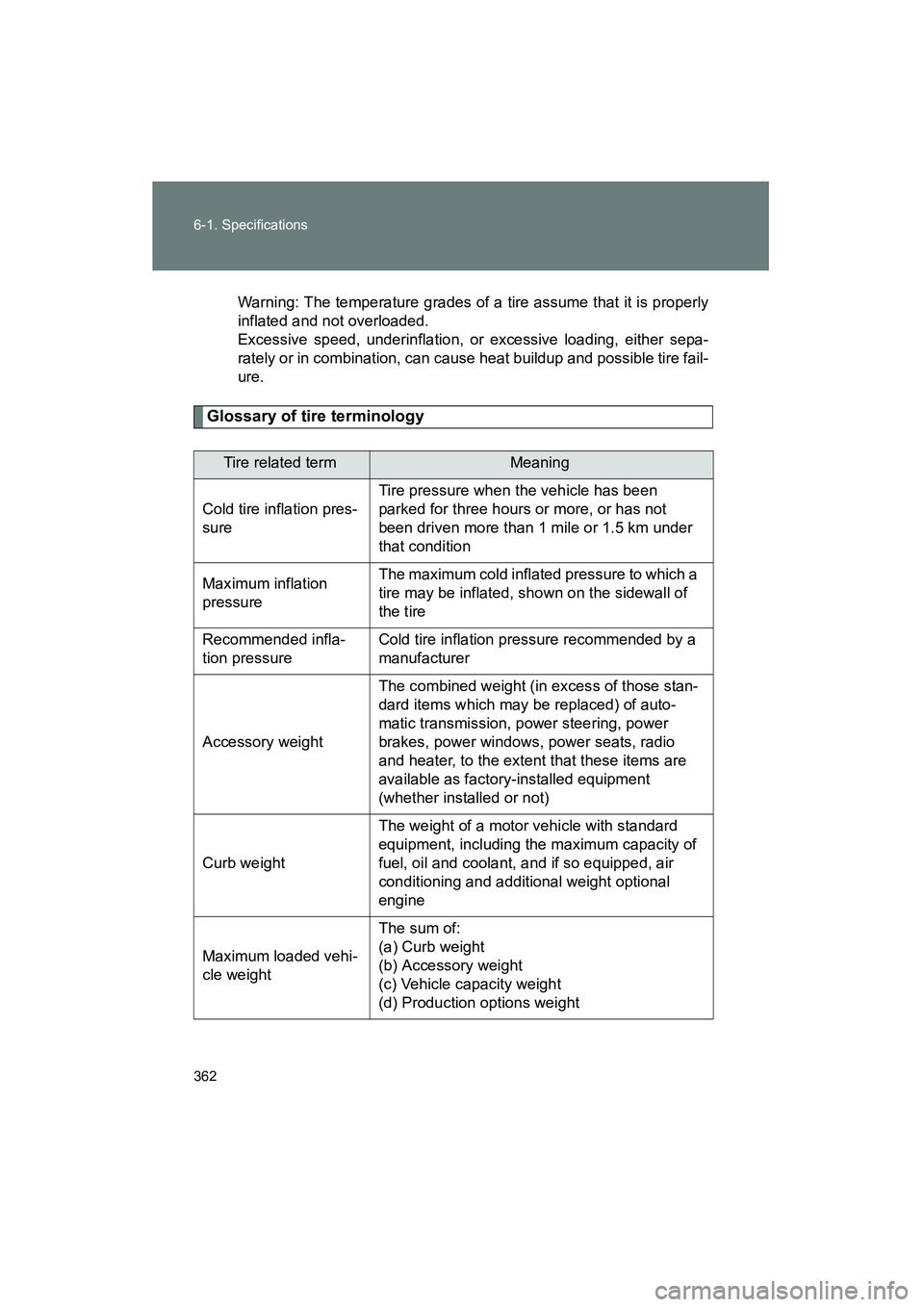Page 330 of 403
328
5-2. Steps to take in an emergency
YARIS_HB_U_52D44U
If the shift lever cannot be shifted from P (vehicles with an automatic transmission)
If the shift lever cannot be shifted with your foot on the brake pedal,
there may be a problem with the shift lock system (a system to pre-
vent accidental operation of the shift lever). Have the vehicle
inspected by your Toyota dealer immediately.
The following steps may be used as an emergency measure to
ensure that the shift lever can be shifted:
Set the parking brake.
Turn the engine switch to the “ACC” position.
Depress the brake pedal.Pry the cover up with a flat-
head screwdriver or equiva-
lent tool.
To prevent damage to the
cover, cover the tip of the
screwdriver with a rag.
Press the shift lock override
button.
The shift lever can be shifted
while the button is pressed.
Page 333 of 403

5
When trouble arises
331
5-2. Steps to take in an emergency
YARIS_HB_U_52D44U
■
Starting the engine when the battery is discharged (vehicles with an
automatic transmission)
The engine cannot be started by push-starting.
■ To prevent battery discharge
●Turn off the headlights and the air co nditioning system while the engine is
off.
● Turn off any unnecessary electrical components when the vehicle is run-
ning at a low speed for an extended period, such as in heavy traffic.
■ When the battery is removed or discharged (vehicles with an alarm
system)
Make sure that the key is not inside the vehicle when recharging or replacing
the battery. The key may be locked in the vehicle if the alarm is activated.
(→ P. 75)
■ Charging the battery
The electricity stored in the battery will discharge gradually even when the
vehicle is not in use, due to natural discharge and the draining effects of cer-
tain electrical appliances. If the vehicle is left for a long time, the battery may
discharge, and the engine may be unable to start. (The battery recharges
automatically during driving.)
Maintain the engine speed of the second vehicle and start
the engine of your vehicle by turning the engine switch to
the “ON” position.
Once the vehicle’s engine has started, remove the jumper
cables in the exact reverse order from which they were con-
nected.
Once the engine starts, have the vehicle inspected at your Toyota
dealer as soon as possible.
Page 339 of 403

5
When trouble arises
337
5-2. Steps to take in an emergency
YARIS_HB_U_52D44U
If the vehicle becomes stuck
■Emergency hook Carry out the following procedures if the tires spin or the vehicle
becomes stuck in mud, dirt, or snow:
Stop the engine. Set the parking brake and shift the shift
lever to P (vehicles with an automatic transmission) or N
(vehicles with a manual transmission).
Remove the mud, snow or sand from around the stuck tire.
Place wood, stones or some other material under the tires
to help provide traction.
Restart the engine.
Shift the shift lever to the D or R position (vehicles with an
automatic transmission) or 1 or R position (vehicles with a
manual transmission) and carefully apply the accelerator to
free the vehicle.
Turn off TRAC and VSC if these functions are hampering your
attempts to free the vehicle. ( →P. 163)
When your vehicle becomes stuck and
cannot move, the emergency hook is
used for another vehicle to pull your vehi-
cle out in an emergency.
Your vehicle is not designed to tow
another vehicle.
Page 340 of 403
338 5-2. Steps to take in an emergency
YARIS_HB_U_52D44U
CAUTION
■When attempting to free a stuck vehicle
If you choose to push the vehicle back and forth to free it, make sure the sur-
rounding area is clear to avoid striking other vehicles, objects or people. The
vehicle may also lunge forward or lunge back suddenly as it becomes free.
Use extreme caution.
■ When shifting the shift lever (vehicles with an automatic transmission)
Be careful not to shift the shift lever with the accelerator pedal depressed.
This may lead to unexpected rapid acceleration of the vehicle that may
cause an accident resulting in death or serious injury.
NOTICE
■To avoid damaging to the transmission and other components
● Avoid spinning the wheels and depressing the accelerator pedal more
than necessary.
● If the vehicle remains stuck even after these procedures are performed,
the vehicle may require towing to be freed.
Page 349 of 403

347
6-1. Specifications
6
Vehicle specifications
YARIS_HB_U_52D44U
Oil viscosity (5W-30 is explained here as an example):
●
The 5W in 5W-30 indicates the characteristic of the oil which allows
cold startability. Oils with a lower value before the W allow for easier
starting of the engine in cold weather.
● The 30 in 5W-30 indicates the viscosity characteristic of the oil when
the oil is at high temperature. An oil with a higher viscosity (one with a
higher value) may be better suited if the vehicle is operated at high
speeds, or under extreme load conditions.
How to read oil container label:
The ILSAC (International Lubricant Standardization and Approval
Committee) Certification Mark is added to some oil containers to help
you select the oil you should use.
Cooling system
Capacity
(Reference) Vehicles with an automatic transmission:
4.9 qt. (4.6 L, 4.0 Imp.qt.)
Vehicles with a manual transmission:
5.0 qt. (4.7 L, 4.1 Imp.qt.)
Coolant typeUse either of the following:
• “Toyota Super Long Life Coolant”
• A similar high-quality ethylene glycol-based non-silicate, non-amine, non-nitrite,
and non-borate coolant with long-life
hybrid organic acid technology
Do not use plain water alone.
Page 351 of 403
349
6-1. Specifications
6
Vehicle specifications
YARIS_HB_U_52D44U
Automatic transmission
*: The fluid capacity is a reference quantity. If replacement is necessary, con-
tact your Toyota dealer.
Manual transmission
Clutch
Fluid capacity*6.8 qt. (6.4 L, 5.6 Imp.qt.)
Fluid type Toyota Genuine ATF WS
NOTICE
■Transmission fluid type
Using transmission fluid other than “Toyota Genuine ATF WS” may cause
deterioration in shift quality, locking up of the transmission accompanied by
vibration and, ultimately, damage to the vehicle’s transmission.
Gear oil capacity (Reference) 2.0 qt. (1.9 L, 1.7 Imp.qt.)
Gear oil type Gear oil API GL-4 or GL-5
Recommended gear oil
viscosity SAE 75W-90
Clutch pedal free play
0.2 0.6 in. (5 15 mm)
Fluid type SAE J1703 or FMVSS No.116 DOT 3
Page 364 of 403

362 6-1. Specifications
YARIS_HB_U_52D44U
Warning: The temperature grades of a tire assume that it is properly
inflated and not overloaded.
Excessive speed, underinflation, or excessive loading, either sepa-
rately or in combination, can cause heat buildup and possible tire fail-
ure.
Glossary of tire terminology
Tire related termMeaning
Cold tire inflation pres-
sure
Tire pressure when the vehicle has been
parked for three hours or more, or has not
been driven more than 1 mile or 1.5 km under
that condition
Maximum inflation
pressureThe maximum cold inflated pressure to which a
tire may be inflated, shown on the sidewall of
the tire
Recommended infla-
tion pressureCold tire inflation pressure recommended by a
manufacturer
Accessory weight
The combined weight (in excess of those stan-
dard items which may be replaced) of auto-
matic transmission, power steering, power
brakes, power windows, power seats, radio
and heater, to the extent that these items are
available as factory-installed equipment
(whether installed or not)
Curb weight
The weight of a motor vehicle with standard
equipment, including the maximum capacity of
fuel, oil and coolant, and if so equipped, air
conditioning and additional weight optional
engine
Maximum loaded vehi-
cle weight
The sum of:
(a) Curb weight
(b) Accessory weight
(c) Vehicle capacity weight
(d) Production options weight
Page 389 of 403

387
YARIS_HB_U_52D44U
Alphabetical index
Alphabetical index
A/C ............................................ 192
ABSABS ...................................... 162
Warning light ........................ 306
Air conditioning filter .............. 269
Air conditioning system
Air conditioning filter ............. 269
Air conditioning system................................ 192
Airbags Airbag operating conditions .... 83
Airbag precautions for your child...................................... 87
Curtain shield airbag operating conditions............. 84
Curtain shield airbag precautions .......................... 87
Front passenger occupant
classification system ............ 92
General airbag precautions .... 87
Indicators................................ 92
Locations of airbags ............... 80
Modification and disposal of airbags ............................. 91
Proper driving posture ...... 78, 87
Side airbag operating conditions............................. 84
Side airbag precautions.......... 87
SRS airbags ........................... 80
Warning light ........................ 306
Alarm .......................................... 74
Antenna ............................ 222, 224
Anti-lock brake system Anti-lock brake system ......... 162
Warning light ........................ 306
Assist grips.............................. 214
Audio input .............................. 200 Audio system
Antenna .........................222, 224
Audio input ............................ 200
AUX port/USB port ................200
Portable music player............ 200
Steering wheel audio switches ..............................201
Automatic transmission Automatic transmission ......... 127
Fluid ...................................... 349
If the shift lever cannot be shifted from P...................... 328
Indicators............................... 136
Shift lock system ...................328
AUX port/USB port ...................200
Back-up lights Replacing light bulbs .............287
Wattage .................................352
Back door ...................................38
Battery Checking ............................... 250
Gravity................................... 348
If the vehicle battery is discharged ..........................330
Preparing and checking before winter .......................172
Warning light .................305, 306
Bottle holders ...........................207
Brake assist ..............................162
Brakes
Fluid ...................................... 249
Parking brake ........................131
Specifications ........................350
Warning light ......................... 305
Break-in tips .............................114A
B